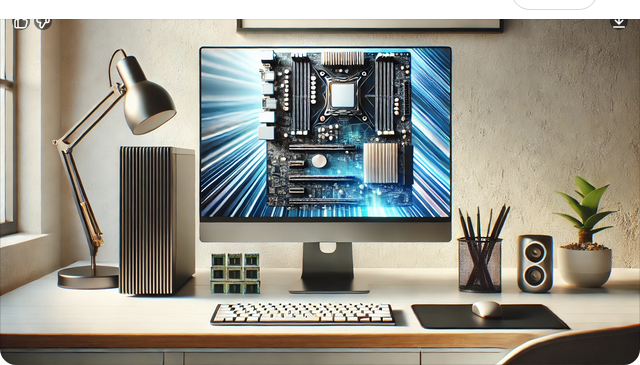What is Hardware? Understanding the Physical Components of Technology
A comprehensive guide to understanding hardware components and their crucial role in enabling technology to function effectively.

Hardware forms the backbone of any technological system. From computers to smartphones, everything relies on hardware to perform functions, execute instructions, and interact with the user. This article will guide you through the key components of hardware, its importance, and how it differs from software. By the end, you’ll have a solid understanding of what hardware is and how it powers modern devices.
What is Hardware?
Hardware refers to the physical parts of a computer or electronic system that you can touch and see. It includes all the components that are crucial for a device to work effectively. Unlike software, which consists of instructions and programs, hardware involves the tangible machinery or devices that run and support the software.
The Role of Hardware in Technology
The role of hardware is to enable the execution of software instructions. It processes data, handles input and output, and supports connectivity within systems. Without hardware, software would have no platform to function on. It is the foundation that allows digital information to be processed, displayed, and stored.
Key Types of Hardware Components
To understand hardware better, let’s explore the various types of components that make up modern technology.
Central Processing Unit (CPU)
The Central Processing Unit (CPU) is often referred to as the “brain” of a computer. It interprets and executes instructions from programs. The CPU is one of the most critical components of any system, as it handles most of the data processing tasks. Its performance directly affects the speed and efficiency of a device.
Random Access Memory (RAM)
Random Access Memory (RAM) is a type of volatile memory that temporarily stores data that the CPU needs to access quickly. The more RAM a system has, the better it can handle multiple tasks simultaneously. RAM plays a crucial role in system speed, especially for tasks like gaming, video editing, and running multiple applications at once.
Motherboard
The motherboard is the main circuit board in a computer or device. It connects all the internal components, such as the CPU, RAM, and storage devices, allowing them to communicate with each other. It also houses critical components like the BIOS and chipset, which manage the system’s hardware configuration.
Graphics Processing Unit (GPU)
The Graphics Processing Unit (GPU), also known as a video card, is responsible for rendering graphics and visual effects. It accelerates the creation of images, videos, and animations. The GPU is particularly important in tasks involving high-performance graphics, such as gaming, video editing, and 3D rendering.
Storage Devices: Hard Disk Drive (HDD) vs. Solid-State Drive (SSD)
Hard Disk Drives (HDDs) and Solid-State Drives (SSDs) are the two primary types of storage devices. HDDs use mechanical parts to read and write data, while SSDs use flash memory, making them faster, quieter, and more durable. SSDs have become more popular due to their speed advantages over traditional HDDs.
Power Supply Unit (PSU)
The Power Supply Unit (PSU) converts electrical energy from an outlet into the correct voltage required by the components of a device. It ensures that the system operates smoothly without any power fluctuations that could damage the hardware.
External Hardware Devices
Input Devices
Input devices are hardware components that allow users to interact with a computer. These include devices such as keyboards, mice, touchpads, and scanners. They send data to the computer, allowing the user to control and operate the system.
Output Devices
Output devices display or produce the results of the computer’s processing. Common output devices include monitors, printers, and speakers. These devices allow users to view the results of their interactions with the system.
Peripheral Devices
Peripheral devices refer to external devices that enhance a system’s functionality. These include items like printers, external hard drives, webcams, and speakers. While not critical for the system’s operation, peripherals expand the device’s capabilities.
The Difference Between Hardware and Software
Hardware vs Software
While hardware refers to the physical components of a system, software refers to the programs, applications, and operating systems that run on the hardware. Hardware provides the platform for software to function, and software directs hardware to perform specific tasks. The relationship between hardware and software is symbiotic—one cannot function effectively without the other.
Other Types of Hardware: Tools and Devices for Everyday Use
Hand Tools and Power Tools
Hand tools such as wrenches, pliers, and screwdrivers are physical devices that allow users to perform tasks like tightening bolts or cutting wires. These tools are essential in both home and professional settings for tasks involving assembly, repairs, and maintenance.
Power tools, such as drills, saws, and sanders, automate physical tasks that would otherwise require more manual effort. These tools are indispensable in construction, manufacturing, and home improvement projects.
Measuring Instruments
Measuring instruments are essential hardware for accurate assessment and analysis. Tools like tape measures, thermometers, and calipers are used in industries ranging from construction to scientific research.
Fasteners and Wrenches
Hardware items such as nails, screws, and bolts are used to hold objects together in construction and manufacturing. Wrenches and pliers are used to apply force to fasteners, tightening or loosening them as needed.
Plumbing and Electrical Tools
Plumbing tools such as pipe wrenches and plungers are used to fix and maintain plumbing systems, while electrical tools like wire strippers and multimeters are essential for electrical work.
Why Hardware Matters in Modern Technology
Hardware forms the foundation of every technological system, whether it’s a computer, smartphone, or industrial machine. Without hardware, software would have no platform to run on, and all digital processes would come to a halt. Hardware enables us to interact with technology, store data, process information, and create digital content.
As technology advances, so does hardware. Devices are becoming faster, more efficient, and more powerful due to improvements in hardware components like CPUs, RAM, and storage devices.
FAQ
Q1: What is the role of the Central Processing Unit (CPU)?
The CPU is the primary component responsible for executing instructions in a computer. It interprets and processes data, making it the “brain” of the system.
Q2: How does Random Access Memory (RAM) affect performance?
More RAM allows a computer to handle more data and applications simultaneously, improving multitasking and overall system performance.
Q3: What is the difference between a Hard Disk Drive (HDD) and a Solid-State Drive (SSD)?
An HDD uses mechanical parts to read and write data, whereas an SSD uses flash memory, making it faster and more durable.
Q4: What is the importance of hardware in a computer?
Hardware provides the physical platform that enables software to run. Without hardware, the software would have no way of interacting with the user or processing information.
Conclusion
Hardware is an integral part of all technology, serving as the physical foundation that supports software. From CPUs to storage devices and external peripherals, each component plays a unique role in making technology function effectively. Understanding hardware is essential for anyone involved in technology, whether you’re a user, technician, or developer. As devices continue to evolve, hardware will remain at the core of technological advancements.
